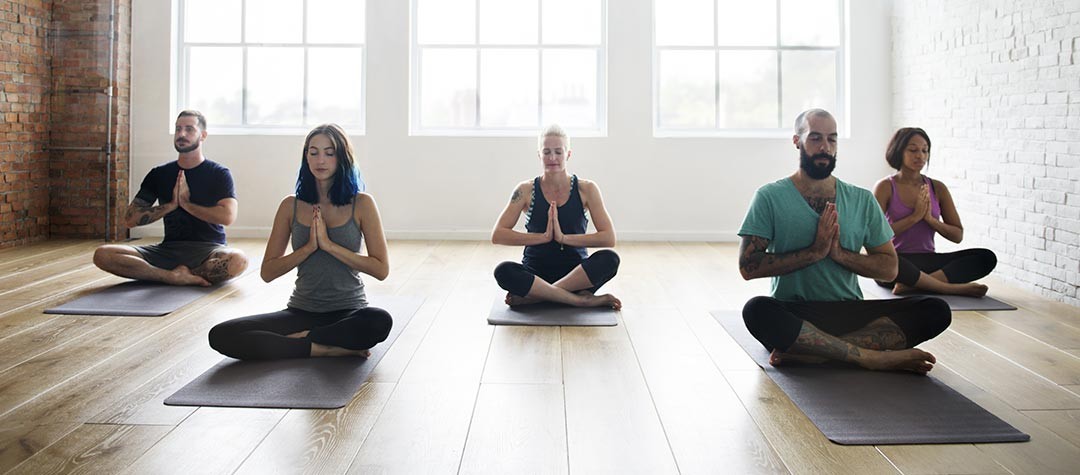Many runners are unaware of the importance of a strong core, which in a bio-mechanical sense is the anchor of your running technique. Without it, running form and technique tend to go out the window when you’re tired and that can lead to stress related injuries. But if you hit the yoga and/or Pilates mat, your centre and indeed everywhere else, will be strengthened, physically and metaphorically.
So what’s the difference between these two activities which are quite often muddled up? Well Pilates is a much younger version of yoga aimed at more of a workout and sculpting the body. Yoga is more of a relaxing and meditative discipline that has holistic and religious values attached to it. But where they are similar, is in their shared benefits to runners.
Yoga
The reason why yoga is so effective for runners is because it involves a dynamic stretching of muscles that are either stressed or tired by over-exercise, or shortened through overuse. The resulting muscle imbalance can cause injury issues of its own, so the stretching and stabilisation of key areas, can really help a runner struggling to meet certain physical challenges.
Think of the workload that your hips, knees, ankles, quads, hamstrings and calves regularly get through. If they aren’t stretched and lengthened properly, over time they will start to recruit help from other muscles that aren’t used to carrying that workload either, or they will break down. Yoga can help prevent that as well as help you recover better and loosen tight areas that might just be hindering a smooth technique. Balance is improved, any back issues can be assisted and overall posture is enhanced.
Yoga is so effective for runners is because it involves a dynamic stretching of muscles that are either stressed or tired by over-exercise, or shortened through overuse.
There are numerous styles of yoga you can try, but pick the right one at the right time in terms of your training. When you’re packing in the miles, opt for more relaxing sessions, because your body will need a break. But if the running workload isn’t too heavy, then you can opt for a more energetic and aerobically challenging version.
It isn’t something for the faint-hearted though because it’s actually quite hard. Apart from a host of positive benefits, which will definitely help your running and potentially improve it, tenacity is another skill you will need. The postures and poses are tough and you will need time to master them. Strength and flexibility will be your reward, as well as a healthy dose of extra physical and mental endurance, because there will be moments when you feel like giving up. Always remember though, stronger muscles mean a greater resistance to injury.
And think of the mental benefits. There is nothing more relaxing than lying down, focusing on your breathing and taking time out of a busy day to clear your mind. It can have enormously refreshing benefits.
Pilates
A stronger core , back and pelvis are the main rewards, as well as increased flexibility, strength and range of movement. The emphasis is on defining and strengthening key muscle areas and if you do it properly, you can really feel the burn.
An improved posture is often the result for people who do Pilates regularly, as it makes you aware of how you stand, walk and sit and a stronger core supports a straighter spine. All of these factors will reduce susceptibility to injury when the miles start to stack up.
A lot of coaches talk of the importance of breathing properly. Many runners breathe from the chest, especially when they pick up the pace, when really they should be breathing from the diaphragm. Pilates teaches deep diaphragmatic breathing, which will help your breathing pattern and rhythm in your running.
Pilates teaches deep diaphragmatic breathing, which will help your breathing pattern and rhythm in your running.
In terms of your lower body your knees take a hammering when you train regularly. But Pilates can help here by strengthening the quads and hip abductors, which support the knee and hips when you run. Anything that you can do to strengthen weak areas will help prevent injury and ultimately provide greater running power.
A lot of runners talk about greater flexibility in muscles and joints after they‘ve regularly attended a Pilates class and the fact that there can be a resistance element, really helps toning and sculpting of certain areas, especially those abs.
You can clear your mind too, perhaps not in the same way as a yoga class which tends to focus more on re-establishing your relationship with your spiritual core, but certainly enough to leave refreshed and reinvigorated. If you have been using it as an active recovery session, you won’t be disappointed and your body will soon start to show the signs of a Pilates tone.














